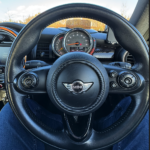

Used MINI buyer checklist
Quick Checklist
- Exterior: Check for rust, dents, and tire condition
- Mechanical: Test drive for noises, check brakes and engine
- Interior: Inspect seats, electronics, and water damage
- Service History: Verify maintenance, mileage, and recalls
- Vehicle History Report: Look for accidents, ownership history, and discrepancies
- Professional Inspection: Consider a comprehensive assessment by a mechanic
Buying a used MINI cooper? Avoid hidden issues with this simple checklist.
Exterior
When you first approach a car, your eyes should be drawn to the exterior. Start by examining the body for any signs of rust or corrosion. This can often be found around the wheel wells, under the doors, and along the edges of the bonnet.
Rust can indicate that the car has been exposed to moisture or has not been properly maintained, which could lead to more significant issues down the line. If you spot any rust, it’s essential to assess how deep it goes; surface rust might be manageable, but if it has penetrated the metal, it could require costly repairs. Next, take a closer look at the paintwork.
Dents, scratches, and paint damage can tell you a lot about how the car has been treated by previous owners. A well-maintained vehicle will typically have a smooth, even finish without noticeable blemishes. If you find scratches or dents, consider how they might affect the car’s resale value.
Additionally, check for any signs of repainting, which could indicate previous accidents or repairs. A consistent paint job is a good sign that the car has been cared for properly. Don’t forget to inspect the tires as well.
The condition of the tires is crucial for safety and performance. Look at the tread depth; it should be sufficient to provide good grip on the road. You can use a simple coin test to gauge this; insert a coin into the tread and see if part of it is covered.
Uneven wear on the tires can signal alignment issues or problems with suspension components. If you notice any bulges or cracks in the sidewalls, it may be time to replace them, which can add to your overall costs.
Mechanical Assessment
Once you’ve completed your exterior inspection, it’s time to take the car for a test drive. Pay close attention to how it feels on the road. Listen for any unusual noises such as clunks, rattles, or squeaks that could indicate underlying mechanical issues.
Vibrations through the steering wheel or seat can also be a sign of problems with the wheels or suspension. A smooth ride is what you should expect from a well-maintained vehicle. During your drive, make sure to test the brakes thoroughly.
They should respond promptly without any grinding sounds or pulling to one side. A soft brake pedal can indicate air in the brake lines or worn-out brake pads. After checking the brakes, assess the steering and suspension.
The steering should feel responsive and direct, while the suspension should absorb bumps without excessive bouncing or swaying. If anything feels off during your drive, it’s worth investigating further. After your test drive, pop the bonnet and take a look at the engine.
Check for any leaks under the car or around engine components; oil spots on the ground can be a red flag. Look for any unusual smells, such as burning oil or coolant, which could indicate serious issues. Smoke coming from the engine is another warning sign that should not be ignored.
A well-maintained engine will typically be clean and free of debris, so if you see excessive grime or corrosion, it may suggest neglect.
Interior Examination

The interior of a car is just as important as its exterior and mechanical condition. Start by inspecting the seats for any signs of wear and tear. Look for cracks in leather upholstery or fraying fabric that could indicate heavy use.
Stains can also be a concern; they not only affect aesthetics but can also lead to unpleasant odours if not addressed properly. A clean and well-maintained interior reflects a car that has been cared for. Next, test all electronic features within the vehicle.
Ensure that the air conditioning blows cold air and that the heating system works effectively as well. Check the radio and any other entertainment systems to confirm they function correctly. Power windows should operate smoothly without any grinding noises, and locks should engage without hesitation.
If you find any issues with these features, it could indicate electrical problems that may require costly repairs. Finally, look for signs of water damage or mould inside the car. This can often be found in areas like under mats or around windows and doors.
A damp smell can also be an indicator of past leaks or flooding incidents. If you notice any signs of mould growth, it’s best to walk away from the purchase as this can lead to health issues and expensive remediation efforts.
Service History
Before making a final decision on purchasing a car, it’s crucial to ask for its service history. A well-documented service record can provide insight into how well the vehicle has been maintained over time. Look for regular maintenance records such as oil changes, brake replacements, and other routine services that indicate responsible ownership.
If there are gaps in service history or if major repairs are missing from documentation, it may raise concerns about how well the car has been cared for. In addition to service records, verify the mileage on the odometer against the overall condition of the vehicle. If a car shows signs of heavy wear but has low mileage, it could suggest that it has been poorly maintained or driven in harsh conditions.
Conversely, high mileage on a well-maintained vehicle may not be as concerning if there is evidence of regular servicing. It’s also wise to check for any outstanding recalls or unresolved issues with the car. Manufacturers often issue recalls for safety-related defects, and it’s essential to ensure that these have been addressed before you make your purchase.
Vehicle History Report
Obtaining a vehicle history report is an important step in your buying process. This report can reveal crucial information about any previous accidents, title issues, or other potential red flags that could affect your decision. If a car has been in a serious accident, it may have hidden damage that could lead to problems later on.
Look for details about how many owners the car has had and whether it has ever been declared a total loss. In addition to accident history, verify the ownership history of the vehicle. Ensure there are no outstanding liens or loans on it that could complicate your purchase.
If there are discrepancies between what is reported in the vehicle history report and what the seller tells you, this should raise alarms about transparency and honesty. A thorough review of this report can save you from making a costly mistake. It’s better to take your time and ensure you have all necessary information before committing to a purchase rather than rushing into something that could lead to regret later on.
A quick online search using the vehicle registration can help you find this information.
Professional Inspection

Consider consulting a professional mechanic for an assessment. During the inspection, ask them to perform a comprehensive check of all mechanical, electrical, and structural components of the vehicle. They will have the expertise to spot potential problems that may not be immediately obvious to an untrained eye. Their assessment can also provide you with an understanding of what repairs might be needed in the near future.
Using their findings can also give you leverage when negotiating the final price with the seller. If they identify issues that need addressing, you can request repairs before completing the sale or negotiate a lower price based on anticipated costs.
Taking this extra step can help ensure that you make a sound investment in your next vehicle while avoiding unexpected surprises down the road.
Ready to find your perfect MINI? Browse trusted listings at MINI Trader or list your MINI for sale today!
Add a comment Cancel reply
You must be logged in to post a comment.
Categories
Recent Posts
Featured Minis for Sale
About us

Mini Trader
Mini Trader is the UK’s dedicated marketplace for MINI enthusiasts, offering a simple way to sell your MINI and browse a wide selection of used MINI cars and parts for sale in the UK.
Related posts

May 28, 2025
Before you embark on the journey of purchasing a MINI Cooper, it’s essential to conduct thorough research and...

Used MINI finance options: Flexible plans explained

Mini Trader
May 27, 2025
When you think about getting a used MINI car, the excitement of owning a stylish and compact car...

Buying a MINI Cooper: A complete guide

Mini Trader
May 26, 2025
The MINI Cooper has long been a symbol of style and fun in the automotive world. With its...

Why do people buy MINI Cooper?

Mini Trader
May 24, 2025
When you think of a car that stands out on the road, the design plays a crucial role....
Top Ratings & Reviews! ![]()
MINI Trader is your premier destination for buying and selling MINI cars, parts and accessories. Our mission is to connect buyers and sellers in a trusted and user-friendly marketplace tailored specifically to the MINI community.
Copyright © 2025, MINI Trader. All rights reserved. MINI Trader is an independent platform and is not affiliated with, endorsed by, or associated with BMW Group or MINI.










